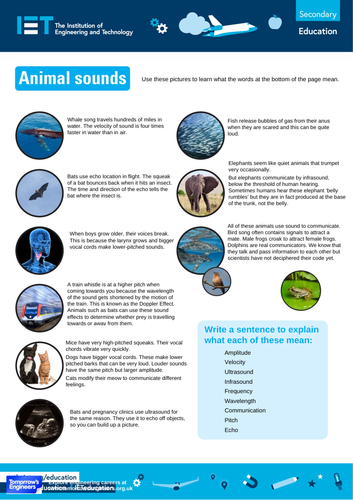


How sounds travel as waves of different frequencies and wavelengths
From founding communications, such as the fire beacon, to being able to communicate with space, there is no denying that developments in communication have advanced at a rapid speed. This topic presents students with communications of the past, present and future, helping them to understand the principles that form the basis for these developments.
This engaging STEM activity is aimed at KS3 students and deals with how animals use sounds and how sounds change in natural phenomena. This is so a student can understand how sound waves travel.
The teacher will first distribute a copy of the ‘Animal Sounds’ handout, which can be downloaded below, to each student.
Make sure students understand sound is a longitudinal wave of compressions and rarefactions of the material. Soundwaves follow the laws of wave behaviour, so they are a useful introduction to wave properties.
This activity can be simplified (particularly for less able students) by creating a discussion on why different animals have different hearing ranges and their experience of phenomena such as the Doppler effect.
Use the handout to discuss different sounds and what they might have learned in other lessons (e.g. music) about pitch, frequency, amplitude etc.
As an extension students could produce a display from low to high frequency, showing where the sound ranges used by different animals lie. Students could consider how sounds outside the normal spectrum could be used to develop new products. For example, to make ‘silent’ devices to broadcast sound or data between two points.
This is a quick and simple activity that will take approximately 15 minutes.
The engineering context
Sounds are vibrations travelling through materials. Many animals make sounds, either for communication or for location. Sound travels at different speeds in different materials. Generally, the denser the material, the faster the sound will travel.
Sound is a longitudinal wave of compressions and rarefactions of the material (a rarefaction involves particles in the material being more spread out than usual). Sound waves follow the laws of wave behaviour, so they are a useful introduction to wave properties.
Suggested learning outcomes
By the end of this free resource students will know that sound is produced by objects vibrating and they will understand that sound is a longitudinal wave. They will also know about the range of frequencies that can be heard by humans and other animals and they will understand that sound travels at different speeds in different mediums.
All activity sheets and supporting resources are free to download, and all the documents are fully editable, so you can tailor them to your students’ and your schools’ needs.
Please share your classroom learning highlights with us @IETeducation
Something went wrong, please try again later.
This resource hasn't been reviewed yet
To ensure quality for our reviews, only customers who have downloaded this resource can review it
Report this resourceto let us know if it violates our terms and conditions.
Our customer service team will review your report and will be in touch.